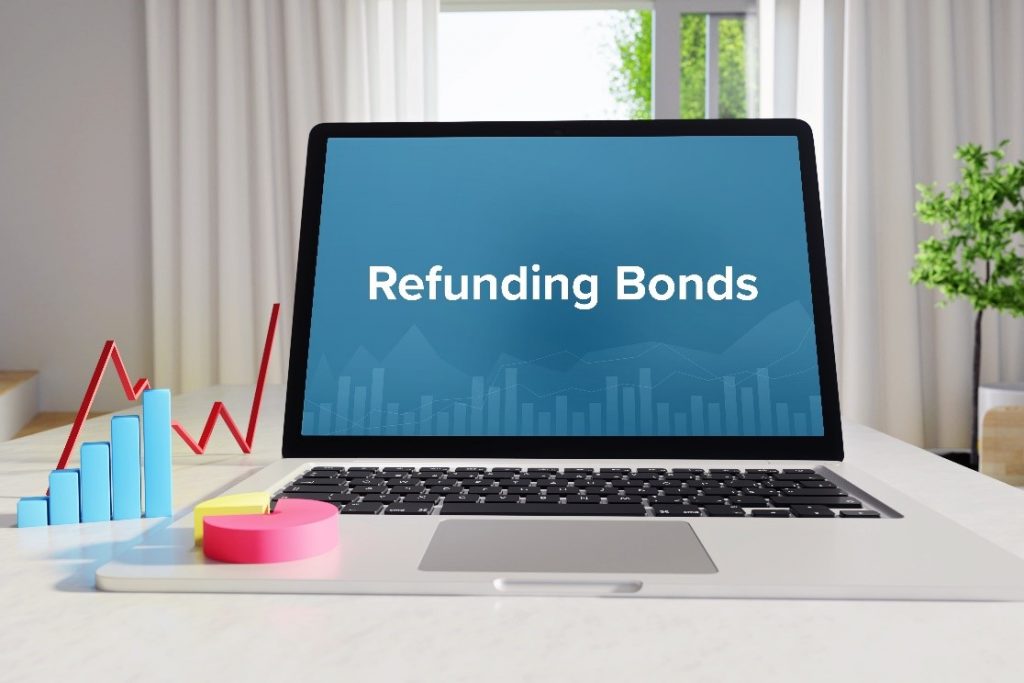Municipal bonds are an important financial instrument for the funding of capital projects for California school and community college districts. Municipal bonds, or “muni bonds”, are issued to raise capital for various projects, such the construction of new facilities or the modernization of existing facilities or infrastructure. However, as economic conditions, interest rates, and financial strategies evolve, districts may find it advantageous to refinance (“refund”) their existing municipal bonds. Refunding bonds are a financial tool that allows districts to replace outstanding bonds with new ones, typically with more favorable interest rates.
Understanding Interest Rates
Chris Hiatt of Keygent explained, “To understand when there may be a refinancing opportunity for outstanding municipal bonds, it is important to understand interest rates and what may affect them.” Interest rates are constantly fluctuating, resulting in periods of overall higher borrowing costs for California school or community colleges and periods of lower borrowing costs. The volatility in interest rates can be influenced by a number of factors including:
- Global Events: Events such as geopolitical tensions, trade disputes, or natural disasters, can create economic uncertainty. During times of global crises, investors may see lower-risk investments, such as municipal bonds, which can drive up demand and result in a lower interest rate environment.
- Economic data: Indicators such as inflation and employment data can influence interest rates. The Federal Reserve closely monitors inflation rates and in times of rising inflation, the Fed may elect to raise interest rates to curb inflation. This would also cause interest rates for municipal bonds to rise. Alternatively, if the Fed decides to cut interest rates, the municipal bond market would also see a decline in interest rates. Employment data can also be a precursor to inflation. During times of strong employment data, such as low unemployment rates, inflation may later occur due to increased consumer spending. The anticipation of future interest rate hikes would result in interest rates rising in the municipal bond market.
- Supply and demand: As supply and demand increases or decreases, it influences interest rates as well. When there is a higher demand for municipal bonds, interest rates decrease as there is increased competition between investors to purchase bonds. If there is a decrease in demand for municipal bonds, interest rates may increase to attract more investors to purchase the bonds.
Global events and economic data have a complex relationship with supply and demand. Investors closely follow economic releases and world events to anticipate potential shifts in interest rates and adjust their investment strategies accordingly. These constant shifts result in a volatile interest rate environment for municipal bonds. In a lower interest rate environment, California school and community college districts may find opportunities to issue refunding bonds.

Keygent: A Quick Background on Refunding Bonds
Keygent’s Chris Hiatt further explained, “Refunding bonds typically replace outstanding municipal bonds that have higher interest rates with new bonds that have lower interest rates.” There are two types of refunding bonds: advanced refundings and current refundings. Typically, outstanding municipal bonds that are refunded have a call provision, which allows a California school or community college district to redeem, or call back, its outstanding bonds prior to their scheduled maturity date. An optional redemption date is when a district has the option to exercise the call provision. Advanced refundings are refunding bonds that are finalized more than 90 days prior to the optional redemption date. The proceeds from the advanced refunding bonds are typically placed in escrow, which may be invested in securities until the call date. Current refundings are refunding bonds that close within 90 days of the optional redemption date.
Prior to January 1, 2018, most advanced and current refundings were issued on a tax-exempt basis. However, the Tax Cuts and Jobs Act of 2017, which went into effect on January 1, 2018, removed the ability for California school and community college districts to advance refund their outstanding municipal bonds on a tax-exempt basis. Districts can still advance refund their outstanding municipal bonds on a taxable basis, while current refundings can still be completed on a tax-exempt basis as well as taxable. Chris of Keygent LLC noted, “Tax-exempt interest rates are lower than taxable interest rates because investors are willing to receive lower interest rates for the benefit of receiving tax-exempt interest.” Despite the difference in interest rates and the inability to issue advance refundings on a tax-exempt basis, both advance and current refunding bonds provide districts with an effective financial tool to manage their outstanding debt and capitalize on favorable market conditions.

When & Why Districts May Consider Issuing Refunding Bonds
When municipal bonds are issued by California school and community college districts, interest rates are “locked in” at the time of bond sale. As previously mentioned, interest rates are constantly fluctuating. Districts may find themselves in an interest rate environment that is lower than at the time the original municipal bonds were sold. During these times, refunding municipal bonds may be a strategic financial move that districts undertake to take advantage of the favorable interest rate market conditions.
Many issuers elect to refund their municipal bonds for the debt service savings that is generated. As refunding bonds typically have lower interest rates, the debt service on the bonds is lower than the bonds that are being refunded. This difference is referred to as ‘debt service savings.’ For general obligation bonds, the debt service savings is passed on to district taxpayers in the form of tax rate savings. For District-backed certificates of participation or leases, the savings is realized by the District in the form of lower future payments.
California school and community college districts may also elect to issue refunding bonds to restructure their outstanding municipal bonds. The ability to restructure outstanding debt is a valuable tool for districts to manage their tax rate. This is helpful when planning for future bond issuances or maintaining a specific tax rate for taxpayers.
In addition to the fiscal benefits of refunding outstanding municipal bonds, districts may also garner community support. By demonstrating to their communities that they remain fiscally responsible to their taxpayers, California school and community college districts could find that their constituents are more likely to support future bond election initiatives to continue funding their capital needs.
“It is important for California school and community college districts to look at all considerations when deciding to move forward with a general obligation bond refunding,” noted Keygent’s Chris Hiatt. While the goal of a refunding is to achieve debt service savings, districts should assess the total costs associated with the refunding bond issuance process. Similar to the issuance of municipal bonds for capital projects, refunding bonds can incur costs such as underwriting fees, legal fees, municipal advisor fees, credit rating fees, and trustee fees. It is often ideal to issue refunding bonds simultaneously with other new issuances, when possible, to save on issuance costs and staff time.
Timing is a critical factor in the success of a refunding bond. Market volatility is one of the biggest challenges California school and community college districts face during the refunding bond issuance process. As the interest rate environment is constantly fluctuating, debt service savings are constantly changing as well until the refunding bonds are sold. Districts should work closely with their underwriter and municipal advisor to achieve their debt service saving goals. While moving forward with a refunding at lower interest rates is a primary motivation, California school and community college districts should also take into consideration the amount of negative arbitrage generated. As previously mentioned, when outstanding bonds are refinanced before their call date, the bond proceeds are placed in an escrow and the funds are typically invested. Sometimes, the interest earned in the escrow is lower than the interest due on the new refunding bonds over the same period of time. This difference is referred to as negative arbitrage. If the interest rate environment were to remain exactly the same and a district waited until the prior bonds were callable, the savings on the refunding bonds would increase by the amount of negative arbitrage. Districts should carefully weigh the amount of negative arbitrage they are willing to accept along with the amount of interest rate risk they are willing to take on if they wanted to wait to refund the outstanding bonds closer to their call date.
There are many considerations California school and community college districts face when determining if they should move forward with a bond refinancing. With the help of a municipal advisor, such as Keygent LLC, they can receive analyses that will help them make an informed decision. In addition to providing them information, the financing team also is there to assist with the refunding bond issuance process should a district decide to move forward.

Keygent: What to Expect During The Refunding Process
The process for issuing refunding bonds generally moves quickly since the primary goal is to take advantage of a lower interest rate environment. Municipal advisors play an important role with identifying refunding opportunities for a district. Municipal advisors, such as Keygent LLC, are regularly monitoring the market and performing analyses on outstanding bonds using market comparables to determine if there are potential refinancing opportunities. When an opportunity is identified, it is shared with the district and district officials will determine if they want to pursue the opportunity.
Once a California school or community college district decides to issue refunding bonds, the process is fairly similar to issuing new money bonds: 1) legal documents are drafted by the district’s bond counsel, 2) the district’s board adopts documents, 3) an updated credit rating is received, 4) marketing for the bonds is done by the underwriters, and 5) the bonds are sold to investors. One of the differences between refunding bonds and bonds issued for funding of projects is that for refunding bonds, districts do not receive the proceeds of the bonds. The proceeds are received by the assigned escrow agent who then will put the funds in an escrow. The funds are held in escrow until the first optional redemption date if it is an advanced refunding or currently refund the outstanding municipal bonds if it is a current refunding.
In some scenarios, issuing refunding bonds can become a drawn-out process. Typically, this will occur if interest rates rise before a district is able to bring their refunding bonds to market. If rates rise and debt service savings evaporate, districts may elect to hold off on the sale of their refunding bonds until the interest rate environment becomes more favorable. “It is important to note that although most fees are paid on a contingent basis, credit rating fees are not. In circumstances where interest rates rise and a refunding is no longer feasible, districts would have to pay for the rating fees out of pocket,” explained Chris Hiatt of Keygent LLC. “Therefore, we try to do everything in our power to avoid delays in the refunding bond issuance process, and to seek opportunities that are most likely to achieve savings, even with slight changes in interest rates during the issuance process.”.
Municipal refunding bonds are a financial tool that allow California school and community college districts to responsibly manage their outstanding debt to benefit their taxpayers. By strategically refinancing outstanding municipal bonds when the interest rate environment is favorable, districts can generate tax rate savings or maintain a specific tax rate for their constituents. Remaining fiscally responsible to voters may increase voter support for future general obligation bond elections, which would be critical for the continued ability to generate funding to upgrade their facilities. However, successfully issuing refunding bonds requires strategic planning and collaboration with the financing team of a district. As California school and community college districts continue to grapple with funding for the improvement and modernization of its facilities, monitoring potential municipal bond refundings is critical to ensure that districts are managing their outstanding debt to benefit its taxpayers.
Keygent LLC is a municipal advisor firm based in El Segundo, California that provides municipal advisory services to California school and community college districts. If you would like to learn more, please visit www.keygentcorp.com to speak with one of their municipal advisors.









